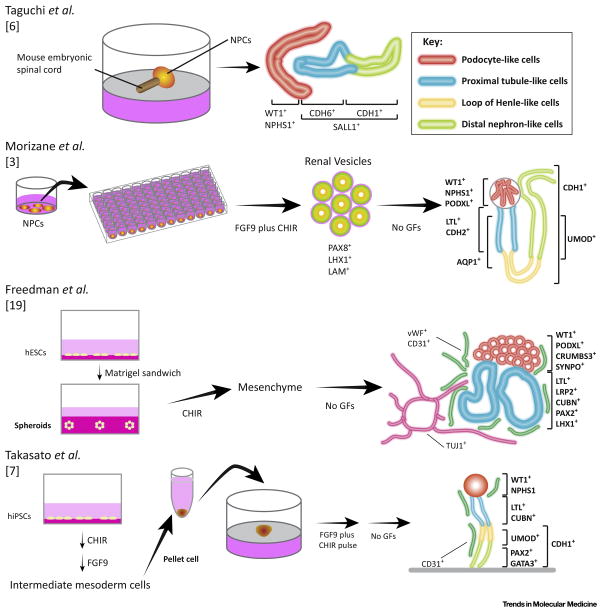Key Figure, Figure 3. Methods for Generating Kidney Organoids.
The diagram depicts recent protocols used to generate kidney organoids from human pluripotent stem cells. Taguchi [6], Morizane [3] and colleagues generated kidney organoids from nephron progenitor cells (NPCs) while Freedman [19], Takasato [7] and colleagues differentiated mesenchyme cells or intermediate mesoderm cells into kidney organoids. Red lines: podocyte-like cells. Light blue lines: proximal tubule-like cells. Yellow lines: loops of Henle-like cells. Light green lines: distal nephron-like cells. NPCs: nephron progenitor cells. WT1: Wilms tumor 1. NPHS1: nephrosis 1, nephrin. CDH6: cadherin 6. CDH1: cadherin 1. SALL1: spalt like transcription factor 1. PAX8: paired box 8. LHX1: LIM homeobox 1. LAM: laminin. PODXL: podocalyxin like. LTL: lotus tetragonolobus lectin. CDH1: cadherin 2. AQP1: aquaporin 1. UMOD: uromodulin. vWF: von Willebrand factor. CD31: cluster of differentiation 31. TUJ1: neuron-specific class 3 beta-tubulin. SYNPO: synaptopodin. LRP2: LDL receptor related protein 2. CUBN: cubilin. PAX2: paired box 2. GATA3: GATA binding protein 3. FGF: fibroblast growth factor. CHIR: CHIR99021.

